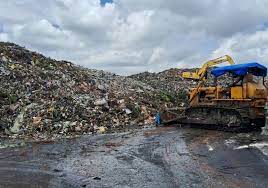Bhubaneswar: Following the failure to set up a waste-to-energy plant at Daruthenga in 2014, and later another unsuccessful venture of micro composting centres (MCC) and material recovery facilities at 43 locations, the Bhubaneswar Municipal Corporation (BMC) has now decided to build a 350-tonne MCC at Palasuni to rid the Capital City of its burgeoning garbage problems. However, doubts have been raised as to whether the civic body’s promises would ever meet with any success on ground given the experience of two failed ventures in the past. BMC Deputy Commissioner (Sanitation) Manoranjan Sahu claimed that on an average 200 tonnes of waste are being processed at 35 MCCs every day. “The work for 350-tonne MCC is underway at Palasuni and it would be completed soon,” he said, adding that the solid waste from Sainik School dump yard is being segregated. The polythene collected from that yard is being sent to Rajgangpur resulting in gradual decrease of the waste volume at Sainik School dumping yard, he asserted.
However, going by BMC’s track record, fingers are crossed over the success of the new initiative to process over 800 tonnes of garbage collected from the City every day. Nevertheless, it is a matter of concern that the BMC has been unable to find a lasting solution to the garbage disposal issue of the City in its 28 years of existence. This in turn has put a population of over 15 lakh to daily misery and unhealthy existence over the years. It may be recalled that in 2014 a waste-to-energy plan was conceived for BMC waste management. Accordingly, the Housing and Urban Development (H&UD) department had signed an MoU with SL Municipal Solid Waste (MSW) Bhubaneswar Ltd to set up a 11-mega-watt power plant at Daruthenga dumping yard for Rs 200 crore.
However, after the Union Ministry of Environment Forest and Climate Change (MoEF&CC) prohibited dumping of waste at Bhuasuni dumping yard, the power plant became a non-starter as the government developed a cold feet to go ahead with the project. After SL Municipal Solid Waste withdrew from the project, the garbage pile-up turned into a hill at Daruthenga. Moreover, many fatal mishaps took place during the transport of waste from Sainik School to Daruthenga. Following protests by residents of Daruthenga village, the transport of garbage from Sainik School dumping yard to Daruthenga was stopped. With no options available, the civic body kept on dumping the entire 800 tonne collected garbage at the temporary transit station (TTS) near Sainik School. Over the years, the waste has taken the shape of a hill and the stench emanating from the sludge put the residents of VSS Nagar, Gajapati Nagar, Gadakana, Chandrasekharpur, Chakheisiani, Rasulgarh and Acharya Vihar to untold miseries.
Moreover, it has raised concerns about polluting groundwater in these areas. Former BMC deputy commissioner Srimanta Mishra said, “The waste-to-energy project became a non-starter after the executing firm withdrew upon failing to mortgage 100 acres of land as collateral.” When matters went ahead, in 2019-20 financial year, BMC decided to decentralise waste management under the direct supervision of H&UD department. Accordingly, MCC and Material Recovery Facility were set up at 43 locations to convert waste into manure. However, this project too hit roadblocks owing to various impediments, said sources. Now, it is to be seen how the upcoming 350-tonne mega MCC project at Palasuni would be able to provide clean air to the residents of smart city and relieve it of its mounting garbage problem.
